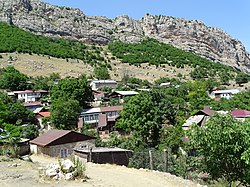Dashalty
Daşaltı / Karintak Քարինտակ | |
|---|---|
 Karintak in June 2015 | |
| Coordinates: Template:Xb_type:city(588) 39°44′30″N 46°44′57″E / 39.74167°N 46.74917°E | |
| de jure Country | |
| de jure Rayon | Shusha |
| de facto Country | |
| de facto Province | Shushi |
| Population (2005) | |
| • Total | 588 |
| Time zone | UTC+4 (AZT) |
| • Summer (DST) | UTC+5 (AZT) |
Dashalty (Azerbaijani: Daşaltı, also Armenian: Քարինտակ, romanized: Karintak), is a village in Nagorno-Karabakh, which is de jure part of Azerbaijan and de facto part of the Republic of Artsakh. The population consists of ethnic Armenians, and both the Azerbaijani and Armenian names of the village mean below-the-rock, referring to the sheer vertical cliffs towering above the village, on top of which Shusha is built.
Shusha located just above this village, was the last Azerbaijani stronghold in the mountainous part of Karabakh to be captured by Armenians in the Karabakh war.[1] On January 26, 1992 Azerbaijani Defense Minister "Mehdiyev led a disastrous sortie out of Shusha to capture the Armenian village of Karintak".[2] dozens of Azerbaijani soldiers died.[3]
The old town square is relatively well preserved, showing some traditional pre-Soviet architecture of the region. There is also a plain village church that was restored by Land and Culture Organization volunteers in 1999–2000. It was originally built in 1816 in the place of a previously existing chapel.[4] About 3 km downriver there is a mossy waterfall named "Zontik", because of its resemblance to an umbrella in the rain.
The village is an overnight stopping point along the Janapar hiking trail.
Images of Dashalty (Karintak)
-
Zontik Waterfall in KarKar Canyon
-
KarKar Canyon
-
Section of Janapar hiking trail passing by the village
-
A destroyed military vehicle in the village
-
General view
References
- ^ Carey Goldberg (1992-05-10). "Armenians Capture Key Karabakh Town : Republics: Both sides agree the fall of the last Azerbaijani stronghold marks a turning point in the four-year struggle over the disputed enclave". Los Angeles Times. Retrieved 2011-09-27.
- ^ Black Garden, Thomas de Waal, page 176
- ^ Black Garden, Thomas de Waal, page 292
- ^ Mkrtchyan, Shahen. Historical-Architectural Monuments of Nagorno Karabagh. Yerevan, 1989. (Շահեն Մկրտչյան, «Լեռնային Ղարաբաղի պատմաճարտարապետական հուշարձանները»)







